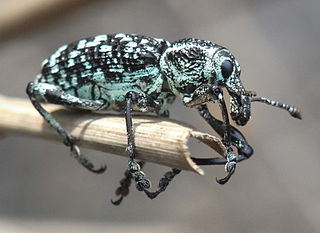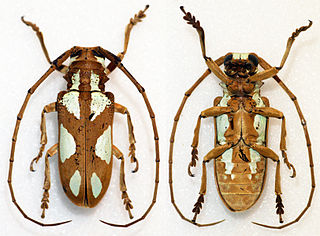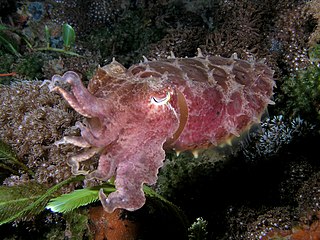
A photonic crystal is an optical nanostructure in which the refractive index changes periodically. This affects the propagation of light in the same way that the structure of natural crystals gives rise to X-ray diffraction and that the atomic lattices of semiconductors affect their conductivity of electrons. Photonic crystals occur in nature in the form of structural coloration and animal reflectors, and, as artificially produced, promise to be useful in a range of applications.

Iridescence is the phenomenon of certain surfaces that appear gradually to change colour as the angle of view or the angle of illumination changes. Iridescence is caused by wave interference of light in microstructures or thin films. Examples of iridescence include soap bubbles, feathers, butterfly wings and seashell nacre, and minerals such as opal. Pearlescence is a related effect where some or most of the reflected light is white. The term pearlescent is used to describe certain paint finishes, usually in the automotive industry, which actually produce iridescent effects.

A distributed Bragg reflector (DBR) is a reflector used in waveguides, such as optical fibers. It is a structure formed from multiple layers of alternating materials with different refractive index, or by periodic variation of some characteristic of a dielectric waveguide, resulting in periodic variation in the effective refractive index in the guide. Each layer boundary causes a partial reflection and refraction of an optical wave. For waves whose vacuum wavelength is close to four times the optical thickness of the layers, the interaction between these beams generates constructive interference, and the layers act as a high-quality reflector. The range of wavelengths that are reflected is called the photonic stopband. Within this range of wavelengths, light is "forbidden" to propagate in the structure.

Teinopalpus imperialis, the Kaisar-i-Hind, is a rare species of swallowtail butterfly found from Nepal and north India east to north Vietnam. The common name literally means "emperor of India". The Kaisar-i-Hind is much sought after by butterfly collectors for its beauty and rarity. The green iridescence of the wings has been found to be due to three-dimensional photonic structure of the scales and is the subject of much research.

Dynastes is a genus of large beetles belonging to the family Scarabaeidae. They occur in the Nearctic realm and in the Neotropical realm, from the United States to Brazil; four North American species, three with distributions extending from Central America either north or south, and two species endemic to South America.

Polyommatinae, the blues, are a diverse subfamily of gossamer-winged butterflies.

Chrysolopus spectabilis is a species of weevil found in south-eastern Australia. It was discovered during James Cook's first voyage, and became one of the first insects to be described from Australia. The weevil measures up to 25 mm (1.0 in) long and includes distinctive metallic green and black scales. It is found only on 28 species of the plant genus Acacia.

The Entiminae are a large subfamily in the weevil family Curculionidae, containing most of the short-nosed weevils, including such genera as Entimus, Otiorhynchus, Phyllobius, Sitona, and Pachyrrhynchus. In comparison with their stunning diversity, only a few of these weevils are notorious pests of major economic importance. Entimines are commonly encountered in the field, including urban environments, and abundant in entomological collections.

The external morphology of Lepidoptera is the physiological structure of the bodies of insects belonging to the order Lepidoptera, also known as butterflies and moths. Lepidoptera are distinguished from other orders by the presence of scales on the external parts of the body and appendages, especially the wings. Butterflies and moths vary in size from microlepidoptera only a few millimetres long, to a wingspan of many inches such as the Atlas moth. Comprising over 160,000 described species, the Lepidoptera possess variations of the basic body structure which has evolved to gain advantages in adaptation and distribution.

Scales are present on the bodies of various insects. A notable example are the Lepidoptera, the insect order comprising moths and butterflies, which have scales on their wings and on the head, parts of the thorax and abdomen, and parts of the genitalia. The name is derived from Ancient Greek λεπίδος (scale) and πτερόν (wing).

Megascolia procer, the giant scoliid wasp, is a solitary wasp in the family Scoliidae found across Asia. It is one of the largest wasps in the world, with a wingspan of 11.6 cm (4.6 in).

Structural coloration in animals, and a few plants, is the production of colour by microscopically structured surfaces fine enough to interfere with visible light instead of pigments, although some structural coloration occurs in combination with pigments. For example, peacock tail feathers are pigmented brown, but their microscopic structure makes them also reflect blue, turquoise, and green light, and they are often iridescent.

Entimus is a genus of broad-nosed weevils belonging to the family true weevil and the Entiminae subfamily.

Entimus splendidus is a species of broad-nosed weevils belonging to the family true weevil and the Entiminae subfamily.

Lamprocyphus augustus is a species of the true weevil family.

Prosopocera lactator, the Turquoise Longhorn, is a species of flat-faced longhorn beetles in the subfamily Lamiinae.

Sternotomis callais is a species of beetle in the family Cerambycidae. It was described by Léon Fairmaire in 1891. It is known from Cameroon, the Republic of the Congo, the Democratic Republic of the Congo, Equatorial Guinea, and Angola. It feeds on Coffea liberica var. dewevrei.

Bio-inspired photonics or bio-inspired optical materials are the application of biomimicry to the field of photonics. This differs slightly from biophotonics which is the study and manipulation of light to observe its interactions with biology. One area that inspiration may be drawn from is structural color, which allows color to appear as a result of the detailed material structure. Other inspiration can be drawn from both static and dynamic camouflage in animals like the chameleon or some cephalopods. Scientists have also been looking to recreate the ability to absorb light using molecules from various plants and microorganisms. Pulling from these heavily evolved constructs allows engineers to improve and optimize existing photonic technologies, whilst also solving existing problems within this field.
Charidotella egregia is a species of leaf beetle described by Carl Henrik Boheman in 1855. Along with Charidotella sexpunctata, it is known as a golden tortoise beetle.
Photonic crystal sensors use photonic crystals: nanostructures composed of periodic arrangements of dielectric materials that interact with light depending on their particular structure, reflecting lights of specific wavelengths at specific angles. Any change in the periodicity or refractive index of the structure can give rise to a change in the reflected color, or the color perceived by the observer or a spectrometer. That simple principle makes them useful colorimetric intuitive sensors for different applications including, but not limited to, environmental analysis, temperature sensing, magnetic sensing, biosensing, diagnostics, food quality control, security, and mechanical sensing. Many animals in nature such as fish or beetles employ responsive photonic crystals for camouflage, signaling or to bait their prey. The variety of materials utilizable in such structures ranging from inorganic, organic as well as plasmonic metal nanoparticles makes these structures highly customizable and versatile. In the case of inorganic materials, variation of the refractive index is the most commonly exploited effect in sensing, while periodicity change is more commonly exhibited in polymer-based sensors. Besides their small size, current developments in manufacturing technologies have made them easy and cheap to fabricate on a larger scale, making them mass-producible and practical.




















